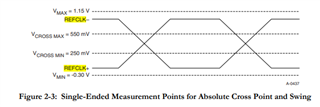Tool/software:
Questions:
1) What is the common mode voltage on receiver clock input pins (RXP, RXN)?
The table in datasheet does not specify DC common mode voltage range that is acceptable/recommended. The table labels the spec VRX-CM-DC = DC(avg) of |VREFCLK+VREFCLK-|/2, but doesn’t include an acceptable level. Our customer's current DC couple implementation has a common mode voltage at around 0.84V. Is this within the recommended level? What is the spec limit?
2) In the datasheet it states that the REFCLK+, REFCLK-, RXP, and RXN do not need external components and thus can be DC coupled rather than AC coupled (ie does not need in-line caps). Is it problematic if these lines were AC coupled exactly like the TXP and TXN lines?
3) Is the REFCLK expected to have a common source between the PCIe link partners (i.e. same oscillator is used to generate REFCLK for both the PCIe switch and the End-Point (DDC PCIe bridge) ?
I see in the datasheet that it says the XIO2001 supports a local generated clock so my first thought is that it is fine not to have the same common source. Correct?
4) When our customer shuts down their board and thus removes the 3.3V from the rail of the XIO2001, a voltage of about 1.6V can be seen on the 3.3V rail of XIO2001. I read in one of the forums that there are power modes such as L2 that cause the XIO2001 to back feed from Aux voltage on to the 3.3V rail. Is this true or did I miss understand this? Our customer has not yet ruled out the cause being something in there system. However, due to the vast number of I/O in there system we are trying to understand where best to look for the cause of this voltage and therefore any information about known issues, signals, or modes that would cause back feeding of the device to the 3.3V rail would be very helpful in directing us where to look first. BTW, at room temp the 1.6V is present on the XIO2001 rails and the device powers up and establishes a link (L0 state) just fine. However, at -40C (after a soak) it does not.
5) When the datasheet states the XIO2001 is rated for -40C, is that case temperature (ie touch temperature of the BGA case rather than internal die temperature achieved by an extended cold soak)?


